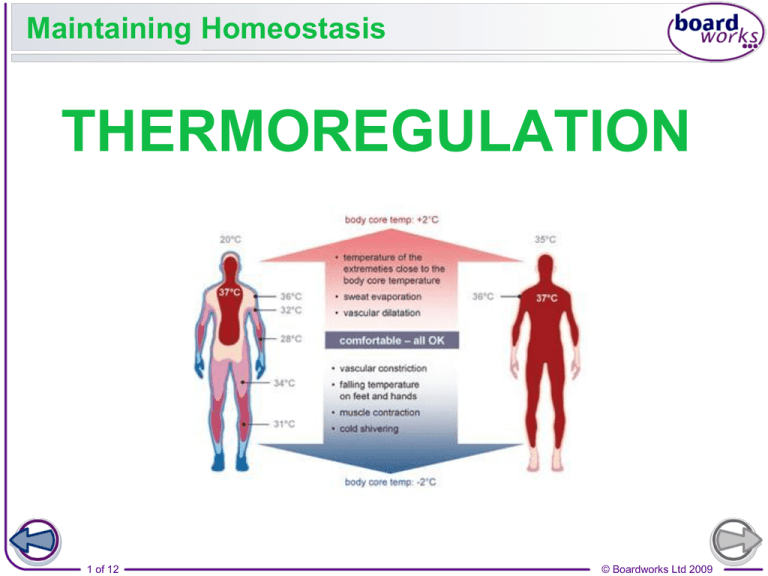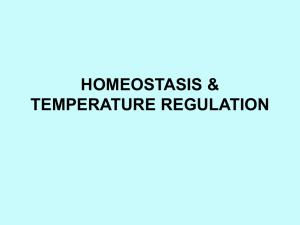Thermoregulation: Maintaining Body Temperature
advertisement

Maintaining Homeostasis THERMOREGULATION 1 of 12 © Boardworks Ltd 2009 Thermoregulation Animals regulate their body temperature using a process called thermoregulation. Thermoregulation is crucial as it helps to maintain the body at the optimal temperature for its enzymes. Some animals live in thermostable environments, such as the open ocean, and have to do very little to maintain their body temperature. Instead their enzymes are adapted to work at their environmental temperature. Environments with fluctuating temperatures provide the greatest challenge for thermoregulation. 2 of 12 © Boardworks Ltd 2009 Heat transfer 3 of 12 © Boardworks Ltd 2009 How is heat gained and lost? 4 of 12 © Boardworks Ltd 2009 Ectotherms and endotherms There are two major strategies for thermoregulation in the animal kingdom: endothermy and ectothermy. Ectotherms do not have control over their internal body temperature. They instead rely on external sources of heat to warm their bodies. Despite this, many ectotherms maintain a near-constant body temperature during their hours of activity. Reptiles and amphibians are ectotherms. Endotherms generate their heat metabolically. Most also maintain a constant internal body temperature, higher than the external environment. Mammals and birds are endotherms. 5 of 12 © Boardworks Ltd 2009 Thermoregulation in ectotherms 6 of 12 © Boardworks Ltd 2009 Thermoregulation in endotherms Endotherms generate most of their heat metabolically. As they are warmer than their environment they tend to lose body heat to their surroundings. Adaptations for heat conservation include: Insulation – insulating layers of fat, fur or feathers to prevent heat loss. Metabolism – metabolic rate can be varied to generate more or less heat. Endotherms also use their skin to vary their rate of heat loss and maintain a constant core body temperature. 7 of 12 © Boardworks Ltd 2009 What’s in skin? 8 of 12 © Boardworks Ltd 2009 The importance of the skin 9 of 12 © Boardworks Ltd 2009 Responding to change 10 of 12 © Boardworks Ltd 2009 Thermoregulation in humans 11 of 12 © Boardworks Ltd 2009 Hyperthermia and hypothermia Prolonged exposure to high temperatures can lead to hyperthermia. The body’s core temperature rises above 41°C causing its thermoregulatory mechanisms to break down. When this happens, positive feedback occurs and the person’s body temperature can spiral out of control. A core body temperature of 43°C and higher usually causes death. If the body’s core temperature falls below 35°C a person may suffer from hypothermia. Again the body’s thermoregulatory mechanisms fail and positive feedback occurs leading to a further decrease in temperature. 12 of 12 © Boardworks Ltd 2009 Physiological thermoregulation 13 of 12 © Boardworks Ltd 2009 Thermoregulatory control system 14 of 12 © Boardworks Ltd 2009

![Direction_and_Scale[1]](http://s2.studylib.net/store/data/005432475_1-80ce3065f13008250a8cdec135db9846-300x300.png)









